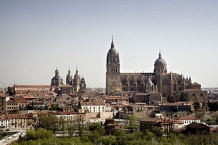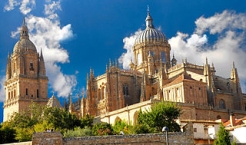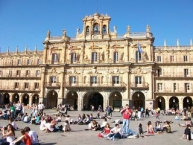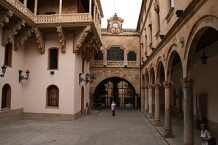Salamanca
Worth visiting
Added on 29 Oct 2012,
last edited by biroto-Redaktion on 29 Oct 2012
Nearby cycle routes and tours
| Route name | Type | Dist. to route |
|---|---|---|
Route | 0,0 km | |
Tour | 0,0 km | |
Tour | 0,0 km | |
Tour | 0,5 km |
![]()
Please wait - map data are loading
Type of sights
Heritage building(s) / World heritage site
Name and address
Salamanca
ES-37001 Salamanca
GEO-data
Geodetic coordinates
40.96∎∎∎∎ -5.66∎∎∎∎
Elevation
809 m
Communication
Information about copyright | |
|---|---|
Rights owner | |
Rights characteristic / license | by: CREATIVE COMMONS Attribution |
Link to the description of the license | |
Image taken over from | |
Image has been uploaded | by biroto-Redaktion on 29 Oct 2012
|
Information about copyright | |
|---|---|
Rights owner | |
Rights characteristic / license | cc0: Public Domain no Rights reserved |
Link to the description of the license | |
Image taken over from | |
Image has been uploaded | by biroto-Redaktion on 29 Oct 2012
|
Information about copyright | |
|---|---|
Rights owner | |
Rights characteristic / license | by-sa: CREATIVE COMMONS Attribution-ShareAlike |
Link to the description of the license | |
Image taken over from | |
Image has been uploaded | by biroto-Redaktion on 29 Oct 2012
|
Information about copyright | |
|---|---|
Rights owner | |
Rights characteristic / license | by: CREATIVE COMMONS Attribution |
Link to the description of the license | |
Image taken over from | en.wikipedia.org/wiki/File:Patio_Palacio_Salinas_(Salamanca).jpg |
Image has been uploaded | by biroto-Redaktion on 29 Oct 2012
|
Salamanca is a city in northwestern Spain, the capital of the Province of Salamanca in the community of Castile and León. Its Old City was declared aUNESCO World Heritage Site in 1988.
Sightseeing in the city, many of them within the «Old quarter», are:
Squares and public spaces
- La Plaza Mayor
: of Baroque style, designed by architects Alberto and Nicolás Churriguera
is the most important of public spaces and the heart of the city.
- Campo de San Francisco: First public garden in the city on grounds of the former convent of San Francisco Real.
- Huerto de Calixto y Melibea: Garden near to the cathedrals where, some say, lies the plot of the novel La Celestina
by Fernando de Rojas
. Besides it are remains of the Roman Walls.
- Plaza del Corrillo: Small square adjacent to the Plaza Mayor. On the left is the Romanesque church of San Martín and the right a series of houses with porches formed by columns of stone completed in pads representing the days of the week (a moon for the Monday, a Mars for Tuesday, etc.).
Religious buildings
- Capilla de la Vera Cruz: Baroque church with Renaissance facade, headquarters of the five hundred year old Brotherhood of the Vera Cruz of Salamanca. It houses countless works of art.
- Cathedrals: Salamanca has two cathedrals, the Old Cathedral
, of the 12th century and of Romanesque style, and the New Cathedral
, much larger, built in 16th century of Gothic style and completed in 18th century. The place where they both join is known as Patio Chico and is one of the most charming corners of the city.
- La Clerecía: currently houses the Pontifical University
. Building started in 1617 and was completed 150 years later as the Colegio Real del Espíritu Santo, of the Society of Jesus
. The style is Baroque. It difference the school, with an interesting cloister and the church, with an impressive facade of three bodies, two twin towers of 50 meters high and a huge dome. The Clerecía name is because it belonged to the Real Clerecía de San Marcos after the expulsion of the Jesuits.
- Colegio de Calatrava : Built in 18th century, by initiative of the Order of Calatrava
, now houses the Casa de la Iglesia.
- Convento de las Agustinas e Iglesia de la Purísima: In the church is a painting of the Immaculate Conception painted by Jusepe de Ribera
. It is the only construction of totally Italian space and decor in Spain.
- Convento de las Dueñas (15th century): Highlights the irregular Renaissance cloister.
- Convento de las Isabeles
- Convento de San Antonio el Real (1736): of Baroque style, its remains were divided between the Lyceum Theatre and a store where it can visit.
- Convento de San Esteban
, of the Dominican
friars (16th century): the plateresque facade, with its shape of an arc of triumph, is a jewel of the Salamancan Renaissance. Impressive Baroque altarpiece by José Benito Churrriguera. Also noteworthy is the Cloister of the Kings, Renaissance.
- Convento de la Anunciación (Calle de las Úrsulas): Founded by the Archbishop Fonseca in 1512. Stresses the exterior apse of Gothic style. In the inside, the Baroque altarpiece and the tomb of the founder, Renaissance, work by Beto
.
- Convento de la Trinidad: Former Palacio de Montellano adapted in 16th century to host a Trinitarian
friary
.
- Monasterio de Nuestra Señora de la Victoria, of the monks
of the Order of St. Jerome
, completed in 1513, almost destroyed by the French in the early 19th century, the Peninsular War
, is now integrated into the manufacturing facilities of the 19th century, of the Grupo Mirat
.
- Ermita de Nuestra Señora de la Misericordia (16th-17th centuries): small Baroque chapel which was begun in 1389 in the Plaza de San Cristobal. Currently very damaged, is a printing, while its bell-gable decorates the church of the Pizarrales neighborhood.
- Antigua Iglesia de las Bernardas work by Rodrigo Gil de Hontañón
. Prototype of the Salamancan churches of the 16th century. Stresses the shell-shaped head. Today it is within the Colegio de San José de Calasanz.
- Iglesia del Carmen de Abajo: Chapel of the Third Order
Carmelites
, incorporated in the Friary of San Andrés. It is the only remnant of that friary, which disappeared in 19th century.
- Iglesia de San Benito: Gothic church built under the patronage of Alonso II de Fonseca, pantheon of the Maldonado family.
- Iglesia de San Julián: Romanesque church subsequently restored.
- Iglesia de San Marcos: Romanesque church near the path which ran the North walls of the city. Outside circular plant has three naves and apses inside.
- Iglesia de San Martín: Romanesque church with Gothic reforms, Renaissance and Baroque, attached to the Plaza Mayor.
- Iglesia de San Pablo: Baroque church belonging to the former convent of the Trinitarians, houses the image of Jesus Rescued, much venerated in the city. Parish hosts, governed by the Diocesan Laborer Priests.
- Iglesia de Santo Tomás Cantuariense: Romanesque church founded in honor of St. Thomas
, Archbishop of Canterbury in 1175, just five years after his death and two after his canonization. It has three apses and a nave with a wooden roof. Form Parish along with St. Paul, governed by the Diocesan Laborer Priests.
University buildings
- University: Set of buildings that made up the former University of Salamanca
, including the Escuelas Mayores, the Escuelas Menores and the Hospital de Estudio (current rectorate). These buildings are situated around the square known as Patio de Escuelas. In this same square is the home of Dr. Álvarez Abarca or of the Doctors of the Queen (15th century), whose facade is Gothic with Renaissance details and is now the Museum of Salamanca.
- Casa-museo de Unamuno (18th century): former home of the rectors of the university. It preserved as in its time it had Miguel de Unamuno
when he took this position.
- Colegio Mayor de Santiago el Zebedeo
, also called "of the Archbishop Fonseca" or "of the Irish" (16th century).
- Colegio de San Ambrosio (1719): Is currently General Archive of the Spanish Civil War
. Houses documents and items seized by the national troops and their allies during and at the end of the Spanish Civil War
. While over the entire postwar its basic objective was to preserve the information related to organizations and peoples potentially opposing the Franco regime, and therefore use this information for repressive, since the return of democracy this building would become one of the most important archives that existed in Spain to investigate the historical period of the Second Republic. Many of the documents and objects that still remain in the archive are related to the Freemasonry
, including several furniture that has been rebuilt a Masonic Lodge
.
- Colegio Trilingüe: founded in 1554 to the teaching of Latin, Greek and Hebrew. It also preserves part of the original courtyard, remade in 1829, in the Faculty of Physics.
- Palacio de Anaya was the last headquarters of the Colegio Mayor de San Bartolomé or Colegio de Anaya founded in 15th century by Don Diego de Anaya, abolished in the early 19th century. Today is the faculty of philology. Next to the building is the Iglesia of San Sebastian, former chapel of the college and the Inn, work by Joaquín de Churriguera.
- Colegio Santa Cruz de Cañizares (16th c.): Music Conservatory. Of it only remains the old chapel, now incorporated into the assembly hall of the conservatory, and the main facade, of plateresque style.
- Colegio de San Pelayo: founded in the mid 16th century. Since 1990 home to the Faculty of Geography and History.
Palaces and palatial houses
- Casa de las Conchas
: built in the late 15th century. of Gothic civil style, its facade is decorated with about 350 shells of scallops, distinctive of the Order of Santiago
. Also important are the bars Gothic windows. It currently houses a public library.
- Casa de Don Diego Maldonado: 16th century Plateresque palace. It houses the Hispanic-Brazilian Cultural Foundation and the Centre for Brazilian Studies at the University of Salamanca.
- Casa de Doña María la Brava: 15th century Gothic building, prototype of the noble mansions of the time. Its owner, María Rodríguez de Monroy was the head of one of the two sides in that split the city in the 15th century. Beheaded the murderers of her children. It is located in the Plaza de los Bandos.
- Casa Lis: Art Nouveau palace of 1905 with iron facade. Built on the walls. It houses the Collections of Art Nouveau and Art Deco donated by Manuel Ramos Andrade.
- Casa de las Muertes (early 16th century), built by Juan de Álava and named such for the skulls that decorate the facade.
- Casa del Regidor Ovalle (18th century): The Spanish writer Miguel de Unamuno
died here.
- Casa de Santa Teresa (16th century): The saint Teresa of Ávila
stayed here when she visited Salamanca in 1570 to found a convent and here she wrote the poem Vivo sin vivir en mí.
- Casa de la Tierra (15th century): doorway with arched, Gothic window tracery. Headquarters of the Chamber of Commerce and Industry of Salamanca.
- Casa de las Viejas (17th century): old workhouse for poor, now the headquarters of the Regional Film Archive of Castile and León. Permanent exhibition of equipment related to cinema and its history, owned by Salamancan filmmaker Basilio Martín Patino
.
- Fonda Veracruz : courtyard with wooden galleries in form of dead-end street. Currently catering school.
- Arias Corvelle Palace (15th century): sgraffito
facade very similar to that of San Boal. It houses the School of Fine and Performing Arts of San Eloy.
- Castellanos Palace (15th-16th centuries): The Palace of the Marquises of Castellanos construction began in the late 15th century, although the facade dates from the late 19th due which combines Gothic and Neoclassical styles. With a powerful Gothic interior courtyard, this building now serves as a hotel.
- Garci Grande Palace (16th c.): Renaissance doorway and chamfered corner windows unique in the city. Head Office of the Savings Bank (Caja Duero
).
- Monterrey Palace: was built in the 16th century and is of plateresque style. Belongs to the House of Alba
and highlight its towers and chimneys. Only it built one of the four parts that composed all designed initially.
- Orellana Palace (16th c.): building of classical architecture with Mannerist
influence. The courtyard in L shape and the ladder.
- Rodríguez de Figueroa Palace (1545): has interesting facades at the streets Concejo and Zamora and interior courtyard. Today the Salamanca Casino.
- La Salina Palace (1546): Renaissance, work by Rodrigo Gil de Hontañón
. Since 1884 is the headquarters of the Provincial Diputation.
- San Boal Palace (15th c.): facade decorated with sgraffitos. Was School of Commerce and later Faculty of Business. Since 1999 is Hispanic-Japanese Cultural Center of the University of Salamanca
. In the same square is the Iglesia de San Boal (17th c.).
- Solís Palace (15th c.): In this palace were married Philip II of Spain
and Maria Manuela of Portugal
in 1543. Today it houses the Telefónica
.
- Tower del Aire: is all that remains of the Palace of the dukes of Fermoselle
, built in the 15th century. It has beautiful Gothic windows. It is currently a student residence.
- Tower del Clavero (15th c.): remains of a palace, apparently built by Francisco de Sotomayor, Clavero Staff of the Order of Alcántara
, about 1470. The lower part is quadrangular, while the upper is octagonal adorned with eight cylindrical turrets.
- Torreón de los Anaya (15th c.): old manor house of Gothic civil style which highlights the mullioned window and the Patio de Tres Lados. For years it was the seat of Institute of Studies of Latin America and Portugal of the University of Salamanca
, also known as Palacio de Abrantes.
Others
- Central Market (1899–1909). Located in the old Plaza de la Verdura. Made of iron.
- Roman Bridge of Salamanca. Of its arches, fifteen are Roman of the 1st century AC. Nearby are the Mudéjar Romanesque church of Santiago (modern reconstruction) and the stone bull quoted in Lazarillo de Tormes
.
Information about copyright | |
|---|---|
Rights characteristic / license | by-sa: CREATIVE COMMONS Attribution-ShareAlike |
Link to the description of the license | |
Input taken over from: |
Wikipedia contributors, 'Salamanca', Wikipedia, The Free Encyclopedia, 22 October 2012, 14:33 UTC, http://en.wikipedia.org/w/index.php?title=Salamanca&oldid=519208878 [accessed 29 October 2012] |
taken over / edited on | 29 Oct 2012
|
taken over / edited by |
|
Nearby cycle routes and tours
| Route name | Type | Dist. to route |
|---|---|---|
Route | 0,0 km | |
Tour | 0,0 km | |
Tour | 0,0 km | |
Tour | 0,5 km |
Added on 29 Oct 2012,
last edited by biroto-Redaktion on 29 Oct 2012




